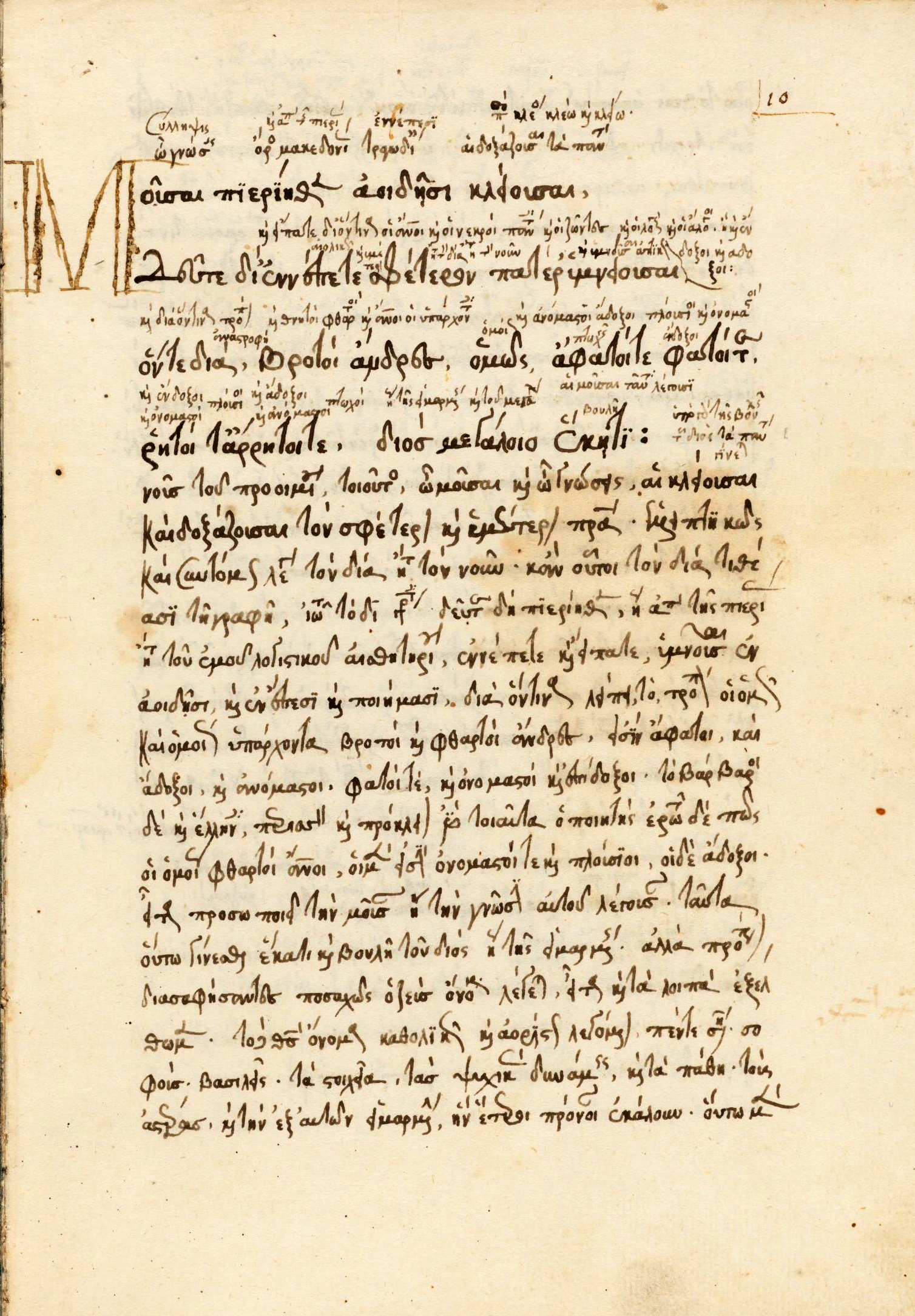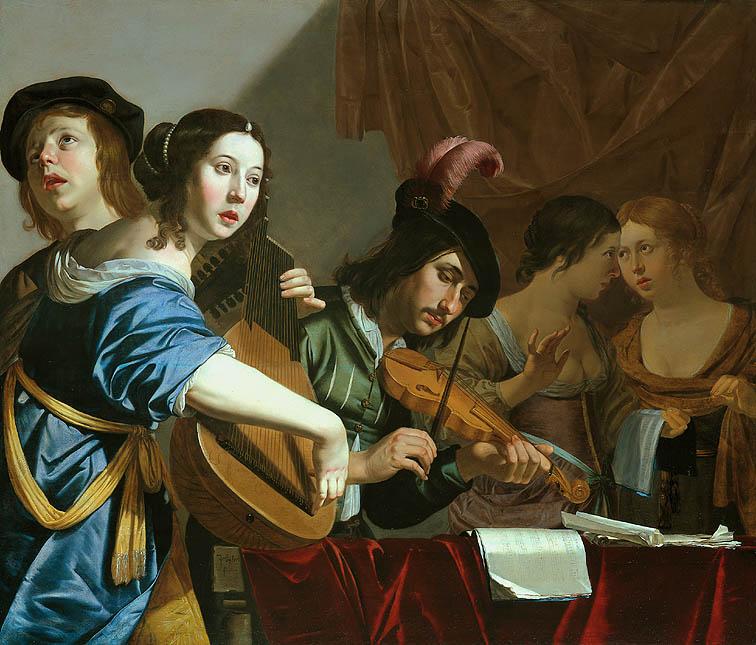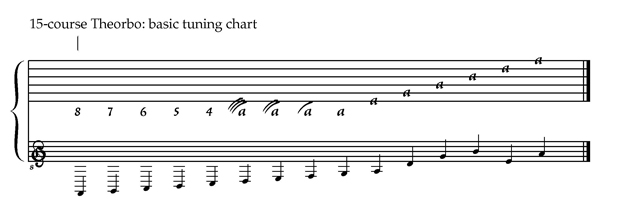|
Monodic
In music, monody refers to a solo vocal style distinguished by having a single melodic line and instrumental accompaniment. Although such music is found in various cultures throughout history, the term is specifically applied to Italian song of the early 17th century, particularly the period from about 1600 to 1640. The term is used both for the style and for individual songs (so one can speak both of monody as a whole as well as a particular monody). The term itself is a recent invention of scholars. No composer of the 17th century ever called a piece a monody. Compositions in monodic form might be called madrigals, motets, or even concertos (in the earlier sense of " concertato", meaning "with instruments"). In poetry, the term monody has become specialized to refer to a poem in which one person laments another's death. (In the context of ancient Greek literature, monody, , could simply refer to lyric poetry sung by a single performer, rather than by a chorus.) History Mus ... [...More Info...] [...Related Items...] OR: [Wikipedia] [Google] [Baidu] |
Ancient Greek Literature
Ancient Greek literature is literature written in the Ancient Greek language from the earliest texts until the time of the Byzantine Empire. The earliest surviving works of ancient Greek literature, dating back to the early Archaic Greece, Archaic period, are the two epic poems the ''Iliad'' and the ''Odyssey'', set in an idealized archaic past today identified as having some relation to the Mycenaean Greece, Mycenaean era. These two epics, along with the Homeric Hymns and the two poems of Hesiod, ''Theogony'' and ''Works and Days'', constituted the major foundations of the Greek literary tradition that would continue into the Classical Greece, Classical, Hellenistic Greece, Hellenistic, and Roman Greece, Roman periods. The lyric poets Sappho, Alcaeus of Mytilene, Alcaeus, and Pindar were highly influential during the early development of the Greek poetic tradition. Aeschylus is the earliest Greek tragic playwright for whom any plays have survived complete. Sophocles is famous fo ... [...More Info...] [...Related Items...] OR: [Wikipedia] [Google] [Baidu] |
Emilio De' Cavalieri
Emilio de' Cavalieri (c. 155011 March 1602), or Emilio dei Cavalieri, the spellings "del" and "Cavaliere" are contemporary typographical errors, was an Italian composer, producer, organist, diplomat, choreographer and dancer at the end of the Renaissance era. His work, along with that of other composers active in Rome, Florence and Venice, was critical in defining the beginning of the musical Baroque era. A member of the Roman School of composers, he was an influential early composer of monody, and wrote what is usually considered to be the first oratorio. Life Cavalieri was born in Rome of an aristocratic and musical family. He was the son of Tommaso de' Cavalieri (c. 1509–1587), a close friend of Michelangelo. He probably received his early training there, and was working as an organist and music director in the period from 1578 to 1584. He spent much of his time in Rome as an organiser of Lenten oratorios. While in Rome he became associated with Cardinal Ferd ... [...More Info...] [...Related Items...] OR: [Wikipedia] [Google] [Baidu] |
Florentine Camerata
The Florentine Camerata, also known as the Camerata de' Bardi, were a group of humanists, musicians, poets and intellectuals in late Renaissance Florence who gathered under the patronage of Count Giovanni de' Bardi to discuss and guide trends in the arts, especially music and drama. They met at the house of Giovanni de' Bardi, and their gatherings had the reputation of having all the most famous men of Florence as frequent guests. After first meeting in 1573, the activity of the Camerata reached its height between 1577 and 1582. While propounding a revival of the Greek dramatic style, the Camerata's musical experiments led to the development of the '' stile recitativo''. In this way it facilitated the composition of dramatic music and the development of opera. Membership The term ''camerata'' is entirely a new construct coined by the members of Bardi's circle, although apparently based on the Italian word for "chamber", ''camera'', a term used for a room where important meeting ... [...More Info...] [...Related Items...] OR: [Wikipedia] [Google] [Baidu] |
Renaissance Music
Renaissance music is traditionally understood to cover European music of the 15th and 16th centuries, later than the Renaissance era as it is understood in other disciplines. Rather than starting from the early 14th-century '' ars nova'', the Trecento music was treated by musicology as a coda to Medieval music and the new era dated from the rise of triadic harmony and the spread of the ' '' contenance angloise'' ' style from Britain to the Burgundian School. A convenient watershed for its end is the adoption of basso continuo at the beginning of the Baroque period. The period may be roughly subdivided, with an early period corresponding to the career of Guillaume Du Fay (c. 1397–1474) and the cultivation of cantilena style, a middle dominated by Franco-Flemish School and the four-part textures favored by Johannes Ockeghem (1410's or 20's – 1497) and Josquin des Prez (late 1450's – 1521), and culminating during the Counter-Reformation in the florid counterpoint of Pal ... [...More Info...] [...Related Items...] OR: [Wikipedia] [Google] [Baidu] |
Madrigal (music)
A madrigal is a form of secular vocal music most typical of the Renaissance (15th–16th c.) and early Baroque (1600–1750) periods, although revisited by some later European composers. The polyphonic madrigal is unaccompanied, and the number of voices varies from two to eight, but usually features three to six voices, whilst the metre of the madrigal varies between two or three tercets, followed by one or two couplets. Unlike the verse-repeating strophic forms sung to the same music, most madrigals are through-composed, featuring different music for each stanza of lyrics, whereby the composer expresses the emotions contained in each line and in single words of the poem being sung. As written by Italianized Franco–Flemish composers in the 1520s, the madrigal partly originated from the three-to-four voice frottola (1470–1530); partly from composers' renewed interest in poetry written in vernacular Italian; partly from the stylistic influence of the French chanson; and fr ... [...More Info...] [...Related Items...] OR: [Wikipedia] [Google] [Baidu] |
Theorbo
The theorbo is a plucked string instrument of the lute family, with an extended neck and a second pegbox. Like a lute, a theorbo has a curved-back sound box (a hollow box) with a wooden top, typically with a sound hole, and a neck extending out from the soundbox. As with the lute, the player plucks or strums the strings with one hand while "fretting" (pressing down) the strings with the other hand; pressing the strings in different places on the neck produces different pitches (notes), thus enabling the performer to play chords, basslines and melodies. It is related to the ''liuto attiorbato'', the French ', the archlute, the German baroque lute, and the '' angélique'' or ''angelica''. A theorbo differs from a regular lute in that the theorbo has a much longer neck which extends beyond the regular fingerboard/neck and a second pegbox at the end of the extended neck. (The pegboxes enable the lute to be tuned by turning the pegs to make the strings sound at higher or lower ... [...More Info...] [...Related Items...] OR: [Wikipedia] [Google] [Baidu] |
Chitarrone
The theorbo is a plucked string instrument of the lute family, with an extended neck and a second pegbox. Like a lute, a theorbo has a curved-back sound box (a hollow box) with a wooden top, typically with a sound hole, and a neck extending out from the soundbox. As with the lute, the player plucks or strums the strings with one hand while "fretting" (pressing down) the strings with the other hand; pressing the strings in different places on the neck produces different pitches (notes), thus enabling the performer to play chords, basslines and melodies. It is related to the ''liuto attiorbato'', the French ', the archlute, the German baroque lute, and the '' angélique'' or ''angelica''. A theorbo differs from a regular lute in that the theorbo has a much longer neck which extends beyond the regular fingerboard/neck and a second pegbox at the end of the extended neck. (The pegboxes enable the lute to be tuned by turning the pegs to make the strings sound at higher or lower pitche ... [...More Info...] [...Related Items...] OR: [Wikipedia] [Google] [Baidu] |
Aria
In music, an aria ( Italian: ; plural: ''arie'' , or ''arias'' in common usage, diminutive form arietta , plural ariette, or in English simply air) is a self-contained piece for one voice, with or without instrumental or orchestral accompaniment, normally part of a larger work. The typical context for arias is opera, but vocal arias also feature in oratorios and cantatas, or they can be stand-alone concert arias. The term was originally used to refer to any expressive melody, usually, but not always, performed by a singer. Etymology The Italian term ''aria'', which derives from the Greek ἀήρ and Latin ''aer'' (air), first appeared in relation to music in the 14th century when it simply signified a manner or style of singing or playing. By the end of the 16th century, the term 'aria' refers to an instrumental form (cf. Santino Garsi da Parma lute works, 'Aria del Gran Duca'). By the early 16th century it was in common use as meaning a simple setting of strophic po ... [...More Info...] [...Related Items...] OR: [Wikipedia] [Google] [Baidu] |
Recitative
Recitative (, also known by its Italian name "''recitativo''" ()) is a style of delivery (much used in operas, oratorios, and cantatas) in which a singer is allowed to adopt the rhythms and delivery of ordinary speech. Recitative does not repeat lines as formally composed songs do. It resembles sung ordinary speech more than a formal musical composition. Recitative can be distinguished on a continuum from more speech-like to more musically sung, with more sustained melodic lines. The mostly syllabic ''recitativo secco'' ("dry", accompanied only by continuo, typically cello and harpsichord) is at one end of the spectrum, through ''recitativo accompagnato'' (using orchestra), the more melismatic arioso, and finally the full-blown aria or ensemble, where the pulse is entirely governed by the music. Secco recitatives can be more improvisatory and free for the singer, since the accompaniment is so sparse; in contrast, when recitative is accompanied by orchestra, the singer must pe ... [...More Info...] [...Related Items...] OR: [Wikipedia] [Google] [Baidu] |
Cantata
A cantata (; ; literally "sung", past participle feminine singular of the Italian verb ''cantare'', "to sing") is a vocal composition with an instrumental accompaniment, typically in several movements, often involving a choir. The meaning of the term changed over time, from the simple single-voice madrigal of the early 17th century, to the multi-voice "cantata da camera" and the "cantata da chiesa" of the later part of that century, from the more substantial dramatic forms of the 18th century to the usually sacred-texted 19th-century cantata, which was effectively a type of short oratorio. Cantatas for use in the liturgy of church services are called church cantata or sacred cantata; other cantatas can be indicated as secular cantatas. Several cantatas were, and still are, written for special occasions, such as Christmas cantatas. Christoph Graupner, Georg Philipp Telemann and Johann Sebastian Bach composed cycles of church cantatas for the occasions of the liturgical year. ... [...More Info...] [...Related Items...] OR: [Wikipedia] [Google] [Baidu] |
France
France (), officially the French Republic ( ), is a country primarily located in Western Europe. It also comprises of Overseas France, overseas regions and territories in the Americas and the Atlantic Ocean, Atlantic, Pacific Ocean, Pacific and Indian Oceans. Its Metropolitan France, metropolitan area extends from the Rhine to the Atlantic Ocean and from the Mediterranean Sea to the English Channel and the North Sea; overseas territories include French Guiana in South America, Saint Pierre and Miquelon in the North Atlantic, the French West Indies, and many islands in Oceania and the Indian Ocean. Due to its several coastal territories, France has the largest exclusive economic zone in the world. France borders Belgium, Luxembourg, Germany, Switzerland, Monaco, Italy, Andorra, and Spain in continental Europe, as well as the Kingdom of the Netherlands, Netherlands, Suriname, and Brazil in the Americas via its overseas territories in French Guiana and Saint Martin (island), ... [...More Info...] [...Related Items...] OR: [Wikipedia] [Google] [Baidu] |
Venetian School (music)
In music history, the Venetian School was the body and work of composers working in Venice from about 1550 to around 1610, many working in the Venetian polychoral style. The Venetian polychoral compositions of the late sixteenth century were among the most famous musical works in Europe, and their influence on musical practice in other countries was enormous. The innovations introduced by the Venetian school, along with the contemporary development of monody and opera in Florence, together define the end of the musical Renaissance and the beginning of the musical Baroque. History Several major factors came together to create the Venetian School. The first was political: after the death of Pope Leo X in 1521 and the Sack of Rome in 1527, the long dominant musical establishment in Rome was eclipsed: many musicians either moved elsewhere or chose not to go to Rome, and Venice was one of several places to have an environment conducive to creativity.Gangwere, p. 246. Another f ... [...More Info...] [...Related Items...] OR: [Wikipedia] [Google] [Baidu] |








